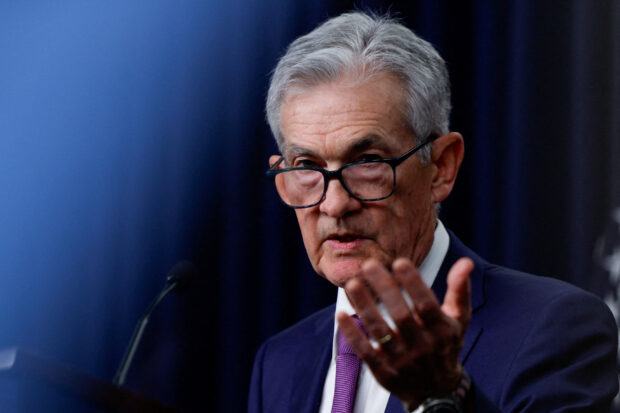Fed’s Powell still sees rate cuts, but inflation progress ‘not assured’

Federal Reserve Chair Jerome Powell holds a press conference following the release of the Fed’s interest rate policy decision at the Federal Reserve in Washington, U.S., Jan 31, 2024. REUTERS/Evelyn Hockstein/File photo
WASHINGTON — U.S. Federal Reserve Chair Jerome Powell on Wednesday assured members of Congress, who will face inflation-weary voters in a charged presidential election year, that upcoming decisions on when and how fast to cut interest rates would be based solely on economic data.
“We’re in a political year,” House Financial Services Committee Chairman Patrick McHenry, a North Carolina Republican, said as he opened a hearing with Powell by quizzing him on the central bank’s rate cut plans and noting that everything the Fed does would be seen through the “lens” of the November presidential rematch between incumbent President Joe Biden, a Democrat, and former Republican President Donald Trump.
Rate cuts “really will depend on the path of the economy. Our focus is on maximum employment and price stability, and the incoming data as they affect the outlook, and those are the things we’ll be looking at,” Powell said.
The Fed “would like to see more data that confirm and make us more confident that inflation is moving sustainably down to 2 percent” before reducing the policy rate.
Powell in prepared remarks to the House panel said rate reductions will “likely be appropriate” later this year, “if the economy evolves broadly as expected.”
READ: Higher forever? Markets see few rate cuts after 2024
But he also cautioned that continued progress on lowering inflation “is not assured,” a fact that is keeping Fed officials from committing to any timetable or pace of rate reductions, with price pressures broadly seen as easing but also some concern that the process of disinflation may stall.
Powell’s opening remarks at the hearing held close to the language he and his colleagues have used to characterize the current state of the economy and the consequential decision of when to start reducing interest rates during an election year.
He noted that inflation had “eased substantially” since hitting 40-year highs in 2022, but remained reluctant to say when Fed officials might reduce a benchmark rate of interest that has been held in the 5.25 percent to 5.5 percent range, the highest in more than 20 years, since July.
READ: US Fed holds key rate steady as Powell says March cut unlikely
He said there were risks of both cutting rates too soon and allowing inflation to reaccelerate, and of keeping monetary policy too tight for too long and damaging an ongoing economic expansion that has sustained a below 4 percent unemployment rate for two years.
Approaching cuts carefully
For the constituents of lawmakers conducting Wednesday’s hearing, a high Fed policy rate means elevated interest rates for home mortgages, credit cards and small business loans, which arguably have contributed to Biden’s current low approval ratings, even as that tough monetary medicine helps relieve the high inflation that takes its own toll on firms and families.
Recent data has done little to clarify the direction of the economy and inflation, with some analysts projecting price pressures to steadily ease, others anticipating inflation will persist, and investors expecting rate cuts to start in June.
Powell “has been very measured in what he said about the overall health of the U.S. economy. And from an inflationary standpoint, we’re not there yet,” said Phil Blancato, chief executive of Ladenburg Thalmann Asset Management in New York. “His comments are going to once again support the narratives that the Fed’s not ready to cut yet.”
READ: Fed signals ‘patience’ on rate cuts as data disappoints
Powell will appear before the Senate Banking Committee on Thursday.
Powell’s testimony comes at a time when inflation is now by some measures within striking distance of the Fed’s 2 percent target, but also as the economy remains unexpectedly strong.
Even as the Fed has kept its policy rate “restrictive,” overall financial conditions have been easing and asset prices rising on expectations of coming rate cuts, a dynamic that could make inflation harder to tame and bolster arguments for further delay.
Since the Fed’s Jan. 30-31 meeting, data has accumulated in a tit-for-tat fashion: Reports bolstering the soft-landing narrative, such as encouraging figures on services prices on Tuesday or signs of slowing consumer spending, have been counterbalanced by others showing inflation stuck in significant ways, such as from still-rising shelter costs, or evidence of unexpected economic strength, such as January’s outsized gain of more than 350,000 jobs.
Inflation within striking distance of target
Powell has made a point as chair to cultivate ties with Democratic and Republican lawmakers. That has been aided by his reputation as a centrist with Republican roots who was named a Fed governor by former President Barack Obama, a Democrat, elevated to chair by Trump and then given a second four-year term as chair by Biden.
READ: Strong services price hikes lifted US producer inflation in Jan
While the deep U.S. cultural divide over issues like abortion and immigration may dominate the campaign, the Fed’s decisions could determine whether the presidential vote occurs in an environment of low inflation, low unemployment and falling interest rates that typically favors an incumbent or in more challenging conditions.
Members of a closely divided but Republican-controlled House all face voters in November. While only some members of the Democratic-led Senate panel are up for reelection, those include Chair Sherrod Brown of Ohio, who has already urged Powell to get rate cuts underway given the decline in inflation.